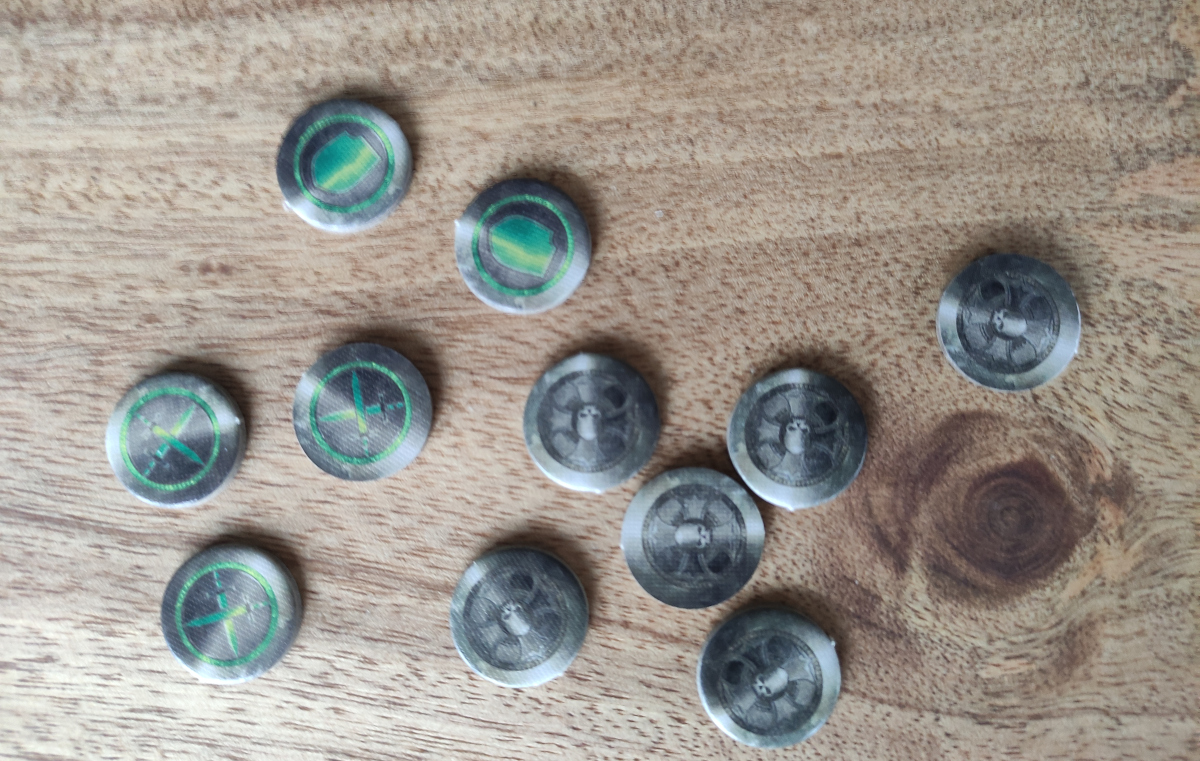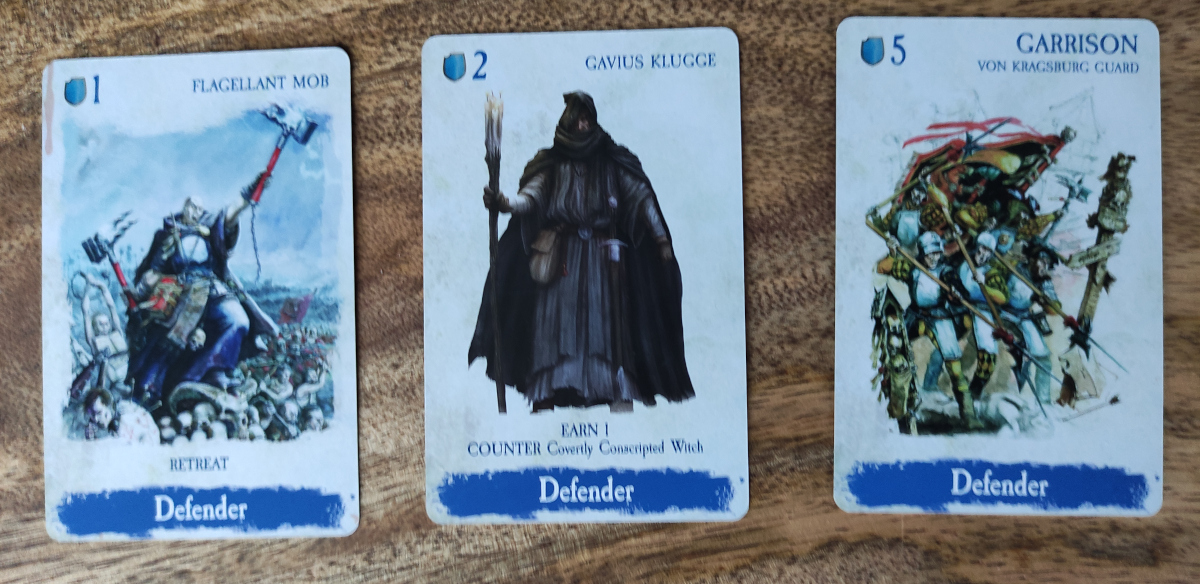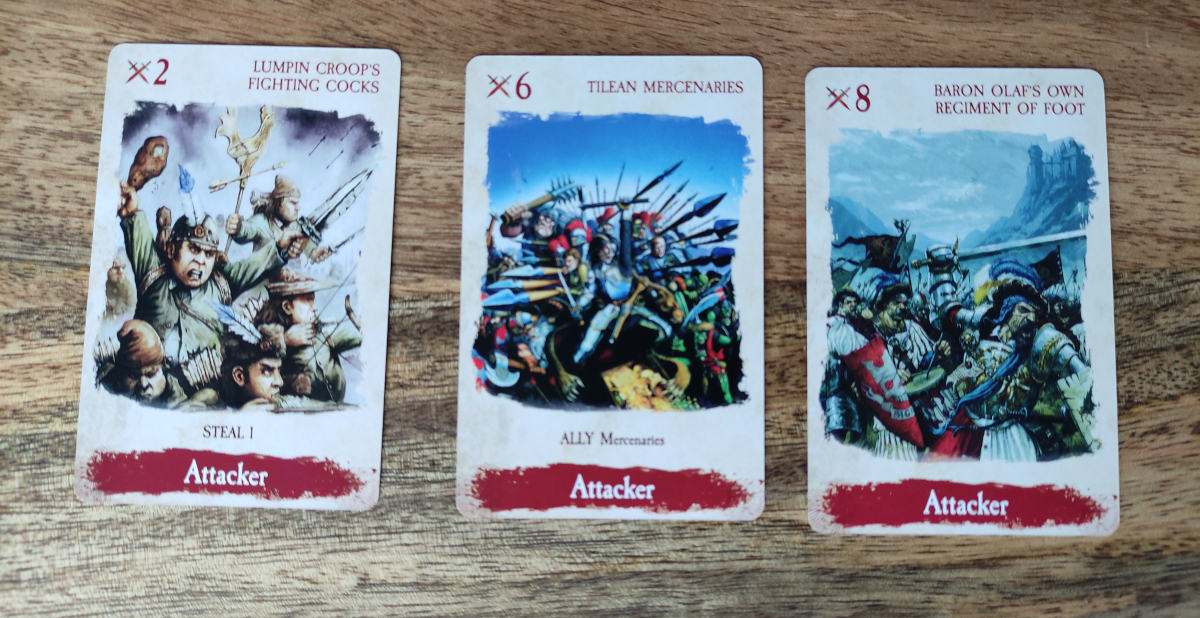Warhammer’s “The Old World” is one of the best-loved fantasy RPG settings. It’s been around for over 30 years, and whilst Games Workshop may have destroyed it to release Warhammer: Age of Sigmar, the Old World still lives on in both print and digital formats. Cubicle7’s 4th of edition of Warhammer Fantasy Roleplay has done an amazing job of bringing the setting back to life for a new generation of gamers. But what about those of us, who don’t have time for a full-on roleplaying session? Step forward super-quick and standalone card game, Elector Counts.
What is Elector Counts?
Elector Counts requires no previous knowledge of Warhammer or The Old World to play. It is a themed abstract card game and a reprint of another Cubicle7 card game, Doctor Who: The Card Game. It’s designed by the acclaimed Martin Wallace.
Elector Counts is for 2-4 players with games taking around 30-40 mins. The game is easily playable by ages around 12 upwards.
In the game, players take on the role of competing Elector Counts embroiled in a civil war. The winner will be able to claim the emperor’s crown. Players raise armies to lay siege to their opponent’s territories whilst also recruiting defenders for their own cities.
Elector Counts features card drafting and hidden units. It’s a lot of fun and its aesthetic is amazing.
What’s in the Elector Counts box?
- Rules (an undaunting 9 pages).
- 28 Siege tokens and 28 Fortification tokens (7 of each per player), 30 Schilling Tokens (the game’s money). 10 spare Schillings.
- 35 attacker cards, 30 Defender Cards, 20 Support Cards and 22 Location Cards.
- 4 Starter Location cards.
- 1 End of the Game card.
- 1 Player Aid Card.
One of the most arresting features of the Old World was its artwork, created during the 80s and 90s by the Games Workshop design studio. This has been brought up to date by the creative team at Cubicle7. The artwork in all of their Warhammer Fantasy Roleplay books is incredible, and, in Elector Counts, it has been repurposed to great effect. Half of the fun of this game is playing with the sumptuously illustrated cards, whether they be showcasing the martial prowess of Imperial forces or the shadow and grime of the Empire’s city streets.
How do you Play Elector Counts?
Each player starts the game with a set number of cards (5 for a 4, player game, 6 for 3 and 7 for 2 players). A player must never end a turn with fewer than three cards in their hand.
Players take alternate turns. During your turn, you may perform any number of actions, though you must never finish your turn with fewer than 3 cards. At the end of your turn, you must pass 3 cards on to the next player.
During a turn, players place cards in front of them in their own play area. If they’re placing attacking cards, these will be placed in an opponent’s play area, next to one of their settlements.
The game ends immediately when one player has either 5 Fortification tokens or 5 Seige tokens in play, or a combined total of 8 of either, at the start of their turn.
The end of game card can also trigger an endgame sequence.
There are one or two subtle differences for a two-player variant. This essentially boils down to removing cards that are broken with only two players.
Set up.
Each player is given a starting location at random. There are 4 starting locations. Unused locations are not used in the game. Each player is given a stock of 3 schillings. The player with the highest value starting location becomes the first player. (The starting locations are numbered 1-4.)
Each player is dealt a hand of cards (as outlined above). Then a draw stack is created by shuffling all of the other cards in the box together. The deck is constructed so that the End of Game card is the 21st card from the bottom of the deck. The draw deck is placed face down in the centre of the players.
Playing your turn.
As stated, at the end of your turn you must be able to pass 3 cards on to the next player. You are allowed to retain up to 2 extra cards in your “reserve.”
Available actions are:
- Play a Location Card from your hand.
- Play one or more Defender cards, placing them on one of your locations.
- Play one or more Attacker cards placing them next to another player’s location card.
- Play a Support card.
- Buy extra cards with Schillings.
- Discard one or two cards in exchange for Schillings.
- Place cards in your reserve.
A player may perform as many actions as they wish and may perform any action more than once.
Once your turn is complete, and you have passed on your three cards, you may draw reinforcements (extra cards): 2 in a 4 player game, 3 for 3 players, and 4 for 2 players. Once it is your turn again, you will be given an additional 3 cards at the end of the previous player’s turn.

Actions in Detail.
The easy ones first!
Discard up to two cards.
As an action, you can discard up to two cards. For each card discarded you may earn two Schillings. Note: This may feel like you ought to be able to discard as many cards as you like at once, since you’re not restricted to the number of actions you can take during your turn. It’s important that it is “up to two,” because, in the situation where the “end of game” card has been drawn, players take it in turns to make a single action at a time.
Note: Schilllings must come from somewhere. If you are required to take Schillings and there aren’t any in the supply you may take them from the other players.
Purchase cards with Schillings.
Conversely, you can spend the Schillings you’ve earned to buy new cards. The exchange rate is 4 Schillings per new card, so you can’t just keep burning cards and replace them with new ones.
Place Cards in Your Reserve.
Whilst you have to pass on 3 each turn, you can keep up to two cards in your reserve to stop other players from utilizing them, or to use them to your advantage when the time is right.
Play a Location Card.
The location cards have full card art on them and represent different places in the Old World. When you play a location card you gain the value in Schillings given on the top left of the card. If you control that location at the end of the game, you gain victory points equal to the number of skulls in the top right corner of the card. Locations are placed directly in front of you.
All players will end up with a suite of locations in front of them which are contested via the attacker and defender cards.
Winning the game is a balance of keeping income coming in from placing locations, but being able to defend them to stop your opponents from controlling too many territories.

Play a Support Card.
Support Cards have different effects depending on the card. Each card explains how it works and how it can be played. Some support cards interrupt the normal flow of play, some are just one-shot cards, and others sit in play until the end of the game or are removed by some other in-game effect.
Committing Cards (Attacking or Defending)
The business end of the game is when you play attacker or defender cards. The cards are played next to locations. Defenders are played next to your location cards and attacking cards against an opponent’s locations.
Cards are usually played face down and so contain some information hidden from your opponents. The cards in the game have a range of numbers on them (from 1-8). The higher the number the stronger the card. You can place more than one card at once and can bolster attacks and defenses with more face-down cards later in the game (they have to still conform to the placement rules for the particular card type).
The card values you commit to your attack or defense are significant in resolving conflict.
Committed cards cannot be withdrawn later in the game.
You are always allowed to look at your own face-down cards later in the game, you don’t have to remember what you have committed where.
Some cards have additional special rules that come into play once they have been revealed. These special rules are often conveyed via the use of keywords. For example, the “EARN” keyword allows you to add Schillings to your coffers when a card bearing that keyword is played.
Play (commit) one or more Defender cards.
You can commit (play) one or more defender cards to one of your locations. You must not put defender cards with the same names under one location (this is surprisingly hard to remember!) and only one card may be a “garrison” card.
If you commit cards to a location that is not under attack, the cards are placed face down. If the location already has one or more attacker cards on it the conflict is resolved immediately. You must commit all the defensive cards you wish to commit before any face-down attacker cards are revealed.
Play (commit) one or more Attacker cards.
You can commit one or more attacker cards to a location owned by another player. Attacker cards must have the same name or the same ALLY keyword.
If you commit attackers to locations that aren’t defended you place them face down. You then place a siege token in your color on top of your attacker cards to show that you control that attack.
You may not attack a location that is already under attack nor can you join forces with another opponent to attack the same location. If you place attacker cards at a location that already has defenders you immediately resolve the attack.
If you attack a location that has a fortification token on it then you immediately discard all attackers (regardless of value, so use cheap ones!) and return the fortification token to player it belonged to. Any Defender cards remain face down in this instance.
Resolving Conflicts.
With players placing defender and attacker cards throughout the game there will inevitably be conflict. The Old World is a bloody place.
Unlike the old days of Warhammer Fantasy Battle these conflicts do not take hours to resolve. Instead, they are over quickly.
When a conflict has to be resolved all the attacker and defender cards at a location are turned face up. Any abilities they have are activated at this point.
The total number of strength points of each stack of cards is totaled. This is rarely more than a couple of cards for each team. Players compare the total values of the defender and attacker stack.
If the defending player’s total strength is EQUAL TO or greater than the attacking player’s total then the defender wins. All defending and attacking cards are placed on the discard pile. The defending player gets to place a fortification token on the location card that is being fought over.
If the attacker has the greater strength, the attacker wins. All defending cards are discarded. The attacked need only discard attacker cards to match the strength of the defender as closely as possible but without exceeding it. This rule is a key point. It makes it worth doubling up your attacks with one big card and one small card, as you often only have to discard the small card, leaving you with a big juicy attacker remaining. The attacker card is left face up and may be reinforced in later turns, or the defending player may place new defenders at this location to force another conflict.
It’s important to note that location cards never move. They’re not captured and transferred to new owners, even if they are successfully attacked. You will only ever be defending locations you place in front of you and attacking locations placed by your opponents.

Ending the Game.
The game ends if a player has 5 Fortifications, 5 Siege Tokens, or a combined total of 8 of both tokens at the START of their turn. Play immediately ceases.
If nobody controls the correct number of tokens before the “End of Game” card is revealed, a different set of end game rules are used. The game can still end as normal if the token limit is reached after the end of game card is drawn.
In the end of game phase, players no longer draw reinforcements and now take it in turns to take a single action. The game is completed once a player has zero playable cards and no Schillings to buy an extra card.
Who Wins?
Whoever has the most victory points wins. Add up all the victory points on each location card in front of you that is not under attack (does not have any attacker cards committed to it). Then add up the victory points on each location card that you have an uncontested attack against.
There is no tie-breaker. Ties end up in a some sort of coalition, which probably means another power struggle in a year or two. Though this game is so much fun, the next conflagration of the Empire is never far away!
Why Play Elector Counts?
If you love the Old World and The Empire you should definitely be playing Elector Counts. The artwork and card design scream Reikland and Drakwald Forest at you. The card art is fabulous, and very true to the original (and existing) Old World aesthetic.
If you’re not into Warhammer or the Old World, then the artwork is still great. It’s a stylized medieval fantasy setting, the type of which may have fallen a little out of favor these days, but when it’s done this well, is still very appealing.
The artwork is good enough to draw you into the game, but are the game mechanics good enough to keep you playing?
I would say so.
Elector Counts is a game that ebbs and flows. If you play it cagey, the deck slowly winds down and then you had better hope you’ve stacked your hand better than your opponents. Put down too many locations and you’re at risk from giving easy targets. Don’t put down enough then you’re likely to be starved of cash and unable to find the resources to build your armies.
Because of the drat and pass aspect of the game, if you focus on taking attacking cards, you’re probably passing on the defenders your opponent needs to fend you off. Decisions matter in Elector Counts, but at the same time they don’t matter too much. The risk of analysis paralysis is limited as it will soon be you turn again, and you can have another attempt at bringing your schemes to fruition.
Elector Counts is a light game, I think not meant to be taken too seriously. Revel in the artwork and enjoy smashing gorgeously drawn armies into each other in way that Warhammer doesn’t allow.
I don’t think you’d ever want to spend all night playing Elector Counts but it’s definitely worth having a hand or two in between other games. It takes a little longer than favorites like Coup or Love Letter but its hidden armies mechanic gives it the same enjoyment of outwitting your opponent. The delight when you hoodwink your opponent into burning an expensive card on a cheap assailant or capturing their city with a lowly 1 point attacker is real.
Because of its martial appearance and innate Warhammeriness it’s probably not going to have the mass appeal that Coup and Love Letter have, but if you like wargames but don’t have time for one, Elector Counts is definitely going to scratch that itch. If you enjoy a bit of social deduction it has that too, without the battle mechanics ever becoming overwhelming. If you like both, then this definitely the game for you!
![]() To subscribe to GeekDad’s tabletop gaming coverage, please copy this link and add it to your RSS reader.
To subscribe to GeekDad’s tabletop gaming coverage, please copy this link and add it to your RSS reader.
Click here to see all our tabletop game reviews.
Disclosure: GeekDad received a copy of this game for review purposes.






